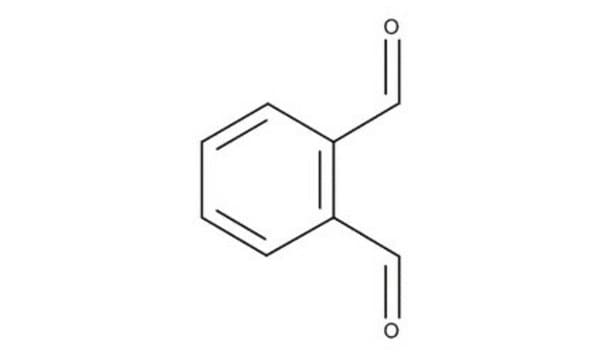79760
Ftaldialdehído
for fluorescence, ≥99.0% (HPLC)
Sinónimos:
Dicarboxaldehído o-ftálico, o-Ftalaldehído, Benceno-1,2-dicarboxaldehído, OPA
About This Item
Productos recomendados
grade
for fluorescence
assay
≥99.0% (HPLC)
form
solid
impurities
≤0.5% phthalic acid
mp
54-56 °C
fluorescence
λex 334 nm; λem 455 nm (Thiol Adduct)
λex 340 nm; λem 450 nm in reaction buffer (with glycine)
storage temp.
2-8°C
SMILES string
O=Cc1ccccc1C=O
InChI
1S/C8H6O2/c9-5-7-3-1-2-4-8(7)6-10/h1-6H
InChI key
ZWLUXSQADUDCSB-UHFFFAOYSA-N
¿Está buscando productos similares? Visita Guía de comparación de productos
General description
Application
Biochem/physiol Actions
signalword
Danger
hcodes
Hazard Classifications
Acute Tox. 3 Oral - Aquatic Acute 1 - Aquatic Chronic 1 - Eye Dam. 1 - Skin Corr. 1B - Skin Sens. 1 - STOT SE 3
target_organs
Respiratory system
Storage Class
6.1A - Combustible acute toxic Cat. 1 and 2 / very toxic hazardous materials
wgk_germany
WGK 3
flash_point_f
269.6 °F - closed cup
flash_point_c
132 °C - closed cup
ppe
Faceshields, Gloves, Goggles, type ABEK (EN14387) respirator filter
Certificados de análisis (COA)
Busque Certificados de análisis (COA) introduciendo el número de lote del producto. Los números de lote se encuentran en la etiqueta del producto después de las palabras «Lot» o «Batch»
¿Ya tiene este producto?
Encuentre la documentación para los productos que ha comprado recientemente en la Biblioteca de documentos.
Los clientes también vieron
Nuestro equipo de científicos tiene experiencia en todas las áreas de investigación: Ciencias de la vida, Ciencia de los materiales, Síntesis química, Cromatografía, Analítica y muchas otras.
Póngase en contacto con el Servicio técnico







